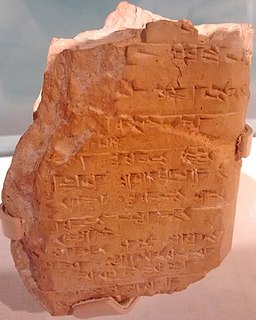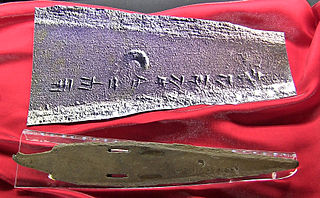Related Research Articles

The Hittites were an Anatolian people who played an important role in establishing first a kingdom in Kussara before 1750 BC, then the Kanesh or Nesha kingdom, and next an empire centered on Hattusa in north-central Anatolia around 1650 BC. This empire reached its height during the mid-14th century BC under Šuppiluliuma I, when it encompassed an area that included most of Anatolia as well as parts of the northern Levant and Upper Mesopotamia.

Kültepe, also known as Kanesh or Nesha, is an archaeological site in Kayseri Province, Turkey. The nearest modern city to Kültepe is Kayseri, about 20 km southwest. It consists of a tell, the actual Kültepe, and a lower town, where an Assyrian settlement was found. Its ancient names are recorded in Assyrian and Hittite sources. In Old Assyrian inscriptions from the 20th and the 19th century BCE, the city was mentioned as Kaneš (Kanesh); in later Hittite inscriptions, the city was mentioned as Neša, or occasionally as Aniša (Anisha). In 2014, the archaeological site was inscribed in the Tentative list of World Heritage Sites in Turkey. It is also the site of discovery of the earliest traces of the Hittite language, the earliest attestation of an Indo-European language, dated to the 20th century BCE.

Mitanni, also called Hanigalbat or Hani-Rabbat in Assyrian or Naharin in Egyptian texts, was a Hurrian-speaking state in northern Syria and southeast Anatolia.

Hittite, also known as Nesite, was an Indo-European language that was spoken by the Hittites, a people of Bronze Age Anatolia who created a mighty state, centred on Hattusa, as well as parts of the northern Levant and Upper Mesopotamia. The language, now long extinct, is attested in cuneiform, in records dating from the 17th to the 13th centuries BCE, with isolated Hittite loanwords and numerous personal names appearing in an Old Assyrian context from as early as the 20th century BCE, making it the earliest-attested of the Indo-European languages.

The Hattians were an ancient Bronze Age people, that inhabited the land of Hatti, in central Anatolia. They spoke a distinctive Hattian language, that was neither Semitic nor Indo-European. Hattians are attested by archeological records from the Early Bronze Age, and also by historical references in later Hittite and other sources. Their main center was the city of Hattush. Faced with Hittite expansion, Hattians were gradually absorbed into the new political and social order, imposed by the Hittites, who were one of the Indo-European-speaking Anatolian peoples. The Hittites kept the country name unchanged, which also became the main designation for the Hittite state.
Hattusili I was a king of the Hittite Old Kingdom. He reigned ca. 1650–1620 BCE as per middle chronology, the most accepted chronology nowadays, or alternatively ca. 1586–1556 BCE. Recent excavations in Zincirli Höyük, Southern Turkey, suggest that Hattusili I destroyed a complex at that site in the mid to late 17th century BCE, which can confirm the middle chronology dating for his reign. This event could have been part of his campaign against Zalpa in order to disrupt an exchange network connected to Aleppo that previously linked the Euphrates, North Syria, and Central Anatolia.
Ammuna was a King of the Hittites ca. 1486–1466 BC. The land seems to have suffered badly during his reign, and he lost a considerable amount of territory.
Telipinu was a king of the Hittites ca. 1460 BC. At the beginning of his reign, the Hittite Empire had contracted to its core territories, having long since lost all of its conquests, made in the former era under Hattusili I and Mursili I – to Arzawa in the West, Mitanni in the East, the Kaskians in the North, and Kizzuwatna in the South.

Anitta, son of Pithana, was a king of Kussara, a city that has yet to be identified. He is the earliest known ruler to compose a text in the Hittite language.

Samʼal, also Zincirli Höyük, is an archaeological site located in the Anti-Taurus Mountains of modern Turkey's Gaziantep Province. It was founded at least as far back as the Early Bronze Age and thrived between 3000 and 2000 BCE, and on the highest part of the upper mound was found a walled citadel of the Middle Bronze Age. New excavations revealed a monumental complex in the Middle Bronze Age II, and another complex that was destroyed in the mid to late 17th century BCE, maybe by Hititte king Hattusili I. It was largely abandoned during the Hittite and Mitanni periods but flourished again in the Iron Age, initially under Luwian-speaking Neo-Hittites, and by 920 BCE had become a kingdom. In the 9th and 8th century BC it came under control of the Neo-Assyrian Empire and by the 7th century BC had become a directly ruled Assyrian province.
Adad-nārārī I, rendered in all but two inscriptions ideographically as mdadad-ZAB+DAḪ, meaning “Adad (is) my helper,” was a king of Assyria during the Middle Assyrian Empire. He is the earliest Assyrian king whose annals survive in any detail. Adad-nārārī I achieved major military victories that further strengthened Assyria. In his inscriptions from Assur he calls himself son of Arik-den-ili, the same filiations being recorded in the Nassouhi kinglist. He is recorded as a son of Enlil-nirari in the Khorsabad kinglist and the SDAS kinglist, probably in error.

Kussara (Kuššar) was a Bronze Age kingdom in Anatolia. The kingdom, though apparently important at one time, is mostly remembered today as the origin of the dynasty that would form the Old Hittite Kingdom.
Huzziya I was a king of the Hittites, ruling for 5 years, ca. 1466–1461 BC.

Zalpuwa, also Zalpa, was a still-undiscovered Bronze Age city in Anatolia of around the 17th century BC. Its history is largely known from the Proclamation of Anitta, CTH 1. But the Zalpa mentioned in the Annals of Hattusili I, CTH 13, is now convincingly identified as Tilmen Höyük, in the Karasu River Valley south of the Taurus Mountains by Tubingen and Chicago Universities recent excavations.

Kaštiliašu IV was the twenty-eighth Kassite king of Babylon and the kingdom contemporarily known as Kar-Duniaš, c. 1232–1225 BC. He succeeded Šagarakti-Šuriaš, who could have been his father, ruled for eight years, and went on to wage war against Assyria resulting in the catastrophic invasion of his homeland and his abject defeat.

The Old Assyrian Empire (Sumero-Akkadian cuneiform: 𒆳𒀭𒊹𒆠 KUR AN-ŠAR2KI, Assyrian cuneiform: mat aš-šur KI, "Country of the city of god Aššur"; also phonetically mat da-šur) is the second of four periods into which the history of Assyria is divided, the other three being the Early Assyrian Period (2600–2025 BC), the Middle Assyrian Empire (1392–934 BC), and the Neo-Assyrian Empire (911–609 BC). Assyria was a major Mesopotamian East Semitic-speaking kingdom and empire of the ancient Near East. Centered on the Tigris–Euphrates river system in Upper Mesopotamia, the Assyrian people came to rule powerful empires at several times. Making up a substantial part of the "cradle of civilization", which included Sumer, the Akkadian Empire, and Babylonia, Assyria was at the height of technological, scientific and cultural achievements at its peak.
Uhna was a king of the ancient Anatolian city of Zalpuwa during the 17th century BC, who conquered the Hittite city of Neša. According to the Text of Anitta, he brought the statue of the god Siusum, from Neša to Zalpuwa. Several years later king Anitta brought this statue back to Neša.

The Middle Assyrian Empire is the period in the history of Assyria between the fall of the Old Assyrian Empire in the 14th century BC and the establishment of the Neo-Assyrian Empire in the 10th century BC.
The following is a list of regions of Ancient Anatolia, also known as "Asia Minor," in the present day Anatolia region of Turkey in Western Asia.
Purushanda was an ancient city-state in central Anatolia, lying south of the Kızılırmak River in what is now modern Turkey. Its site has yet to be discovered. It may have been situated south-east of Lake Tuz, possibly on the mound of Acemhöyük approximately 6 kilometres (3.7 mi) north-west of the city of Aksaray. Another possible location is the mound of Karahöyük near Konya.
References
- ↑ Trevor Bryce (2005). The Kingdom of the Hittites. Oxford University Press. pp. 39–40.
- ↑ Erich Neu (1974). Der Anitta-Text. Harrassowitz. p. 102.
- ↑ William James Hamblin (2006). Warfare in the Ancient Near East to 1600 BC. Routledge. p. 293..
- ↑ Massimo Forlanini (2010). "An Attempt at Reconstructing the Branches of the Hittite Royal Family of the Early Kingdom Period". In Yoram Cohen; Amir Gilan; Jared L Miller (eds.). Pax Hethitica: Studies on the Hittites and their Neighbours in honour of Itamar Singer. Harrassowitz Verlag. pp. 119–123.